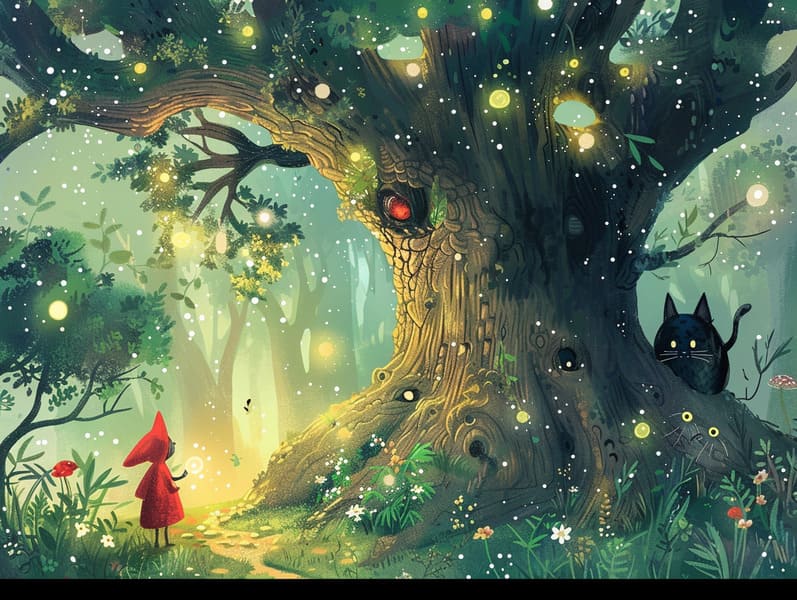
Popular fairy tales have deep roots. These narratives have been recounted from one generation to the next ages before they were ever written down. They came from a variety of traditions, including African traditions. They were initially transmitted among elders, often carrying themes and messages related to the societal norms and beliefs of the time.
The Grimm brothers, Jacob and Wilhelm (the Grimm brothers), were among the first to gather and publish many of these beloved stories. Their anthology, "Grimm's Folk Tales," included stories like "Cinder Maid," "The Story of Hansel and Gretel," and "Little Snow White," which have since become classics in the world of beloved fairy tales. Similarly, Andersen's fantastical fairy tales, such as "The Mermaid's Tale," and "The Duckling that Could," have captivated hearts worldwide, solidifying their place in the pantheon of timeless fairy tales.
Even though they are old, these stories remain as meaningful as ever, especially as bedtime stories for kids. These magical stories are now available in different formats, including beautifully illustrated books, magical animations, and web-based fairy tales.
Their continued relevance can be linked to several magical reasons:
Key Lessons: Timeless fairy tales often present important moral lessons. Narratives like "The Tale of the Boy Who Cried Wolf" teach the value of truthfulness, while "The Hare and the Tortoise" point out the virtues of tenacity and humility. These narratives offer the young clear distinctions between ethical and unethical, helping to shape their moral compass in a mild yet profound way.
Compassion and Insight: Timeless fairy tales frequently portray figures facing problems and hurdles, fostering young listeners to understand with their struggles and back their triumphs. For instance, "Beauty's Beast" conveys the significance of appreciating inner worth to appreciate the inner spirit of a character, developing compassion and perception.
Cultural Perception: Many ancient fairy tales are rich in the cultural contexts from which they bloomed. Immersing in these stories can provide enlightening views into different ways of life, building a sense of world insight and respect.
Inventiveness and Imagination: The fanciful elements in ancient fairy tales—fairy godmothers—spark children’s visions. These narratives transport readers to magical realms, fostering inventive ideas and a sense of enchantment that lasts a lifetime.
Traditional fairy tales are not only bewitching but also enlightening. They provide entrancing tools in developing various cognitive and emotional skills in young readers. When traditional fairy tales are spoken, they advance language acquisition by bringing new word meanings and complicated sentence structures. This practice also cultivates listening skills and attention span, as kids concentrate deeply, enthusiastic to see what happens next.
Furthermore, examining the themes and characters of ancient fairy tales can sharpen critical thinking and thought processes. Little ones are led to see patterns, guess what will happen, and comprehend cause and effect. These analyses also further young ones speak out their thoughts and feelings, strengthening their emotional intelligence.
In today’s modern era, the existence of free fairy tales online has made these fairy tales more reachable than ever. Digital sites and programs provide large libraries of old fairy tales that can be experienced or listened through anytime, anywhere. Fairy tales narrated are particularly in demand, featuring an interactive way for young readers to experience these charming stories. Sound books and narrated videos transport characters and settings to life, often joined by delightful sound effects and tunes that heighten the tale journey.
The enduring charm of ancient fairy tales lies in their ability to transform to modern days while staying true to their fundamental ideas. Contemporary reinterpretations of these tales often present more inclusive protagonists and modern settings, making them familiar to today’s audience. However, the basic principles of fortitude, kindness, and fairness remain unchanged, continuing to affect young listeners of all ages.
Ancient fairy tales also offer a sense of contentment and knowability. They bestow a tidy narrative with a clear beginning, middle, and end, often concluding with the termination of conflicts and the triumph of virtue over wickedness. This uniformity can be reassuring for children, granting a sense of solidity in an constantly changing world.
Old fairy tales continue to enthrall and guide new generations, maintaining their charm and pertinence in modern society. As children's night stories, they allow a perfect blend of magic and knowledge, enhancing moral values, empathy, and creativity. The presence of internet fairy tales and the prevalence of fairy tales voiced assure that these ancient fairy tales remain attainable to new generations.
By continuing and disseminating these narratives, we continue to appreciate the rich tapestry of cultural legacy and cultural heritage. Whether you are enjoying a richly illustrated book, experiencing a internet library, or playing an read-aloud book, the charm of children's fairy tales is always within reach. These tales reveal of the perpetual spell of tales and its ability to link us across eras and regions.
If you are viewing a richly illustrated book, discovering a electronic collection, or listening via an voice book, the delight of popular fairy tales is always within reach.
These tales demonstrate of the timeless website power of stories and its ability to bind us across centuries and lands, weaving a spell that enchants and educates alike.